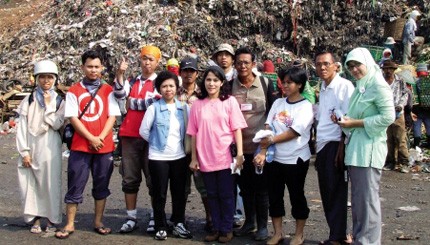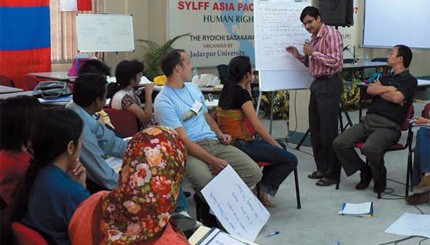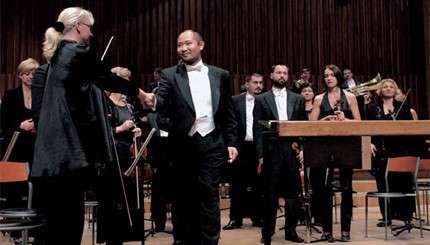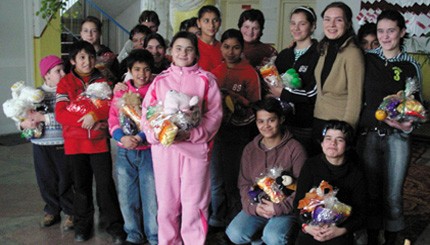
University of Indonesia’s Fellows’ Project on Environmental Awareness Building
August 7, 2008

August 7, 2008

August 7, 2008

August 7, 2008

August 7, 2008


August 1, 2008
By 21136
Tonga will hail a new king in August 2008. A Sylff fellow from New Zealand, who conducted field research in the country, suggests that Tonga must improve cultural relations following November 2006 riots caused by ethnic tension between Tongans and Overseas Chinese and political rivalry between the state and opposition pro-democracy factions.
Tonga is an archipelago in the South Pacific Ocean. The earliest ethnic Chinese arrived there as Anglican priests in the 1920s. It was not until 1974 that the first Taiwanese businessman settled there, and thereupon began a gradual increase in the Overseas Chinese (OC) population--mainly from Taiwan, with some from Hong Kong and some students from the People's Republic of China after the 1989 Tiananmen Incident
Today, there are approximately 600-700 ethnic Chinese residents on the main island of Tongatapu--less than 1% of the country's total population. However, the relatively sudden influx of Chinese migrants, the illegal selling of passports, and the subsequent government decision to make this legal have aggravated ethnic tensions. Resentment of OC immigrants has been manifested in various ways. Graffiti is scrawled across the outer walls of the PRC embassy; there are numerous cases of harassment and assaults against Chinese businessmen;2 Tu'ivakano, chieftain of Nukunuku, banned Chinese stores in his district; and in late 2001, 600 ethnic Chinese were asked by the government to leave once their work permits expired in order to curb violence and anger against Chinese.
These tensions are tied to conflict within the royal family and its links with China. Princess Pilolevu has many business interests with the PRC and, along with her late father, was a strong supporter of Chinese immigration as a means to stimulate the economy. Further links with China are illustrated by bilateral deals involving fisheries, manufacturing and agriculture, and most importantly, the severing of diplomatic ties with Taiwan. Prince 'Ulakalala had another view, deciding that the economy should not be open to foreigners, and used ethnic Chinese as the scapegoat for the island nation's continuing economic malaise.3
Former New Zealand High Commissioner to Tonga Brian Smythe noted upon his retirement in 2003 that "public resentment at the rapid intrusion of Chinese immigrants into the retail sector seems to have diminished somewhat but could always resurface.4 His words would ring true. On November 16, 2006, entire blocks of Nuku'alofa's central business district were left in smoldering ruins following pro-democracy demonstrations. Out of 155 businesses damaged, 33 shops owned by Chinese nationals or naturalized Tongans of Chinese descent were systematically targeted for looting and then torched.5 Several OC businesses along the shoreline (about 10 minutes away on foot) were first cased by scouts, who then advised looters and arsonists by mobile telephone. It is important to note that only property was targeted, and not the people themselves. This all pointed to coordinated planning, preparation, and careful execution.6
One report suggested the Chinese were attacked because of their support for the government.7 However, Chinese keep mostly to themselves and their businesses, with little interest in politics. Rather, it was a small minority of Tongans, such as whose in the pro-democratic Pangai Sii movement and the xenophobic Tonga National Business Association, who had focused negatively on Chinese and urged targeting of their businesses.8 Thugs were hired by Tongan business owners to attack rival operators.910 Police intelligence confirmed these allegations. Commissioner Sinilau Kolokihakaufisi commented, "There was a struggle against the Chinese presence. They were not wanted and that's not democracy. Our investigations will include claims that there were other motives other than democracy behind the riot."11
Violence in Nuku'alofa was quickly contained the same night the riots began.12 However, hundreds of Chinese were left homeless. The PRC embassy made great efforts to provide assistance. It managed to feed, clothe, and house about 300 Chinese in its compound over five days, assisted by large donations from the OC community and sympathetic Tongans. An Air China Boeing 747 was sent to Nadi (Fiji) with food and necessities, to investigate the situation, and to rescue those requiring evacuation.13 The plane arrived back in Xiamen, China, on November 23, 2006.14 Jeremy Chan, an OC community member with Tongan citizenship who opted to remain, said those leaving "will probably never return."15 But this would not be the case.
The OC population controls a large proportion of businesses and services in the Pacific region. There would be significant repercussions for the local economy if this population were to be displaced or removed--investment would fall, unemployment would rise, and there would be fewer choices for and less access to supplies. The Pacific remains an economically attractive OC market and destination, and there is no indication they would voluntary leave permanently en masse. While the evacuation was necessary for those genuinely escaping the turmoil, the majority declined the offer. Some chose to stay and look after their businesses; some could not return to China because of the circumstances in which they left the country in the first place;16 and others were not even in Nuku'alofa at the time of the riots, given their transnational nature.
Of the 193 OC community members who left Tonga after the riots, most returned within a couple of months to rebuild their businesses or start new ones--mostly outside the central business district, which remains empty blocks of land. Anecdotal evidence suggests that the number of new Chinese arrivals may have even increased, with migrants believing more business opportunities have surfaced since the rioting. The only group not to return were young children, whose parents preferred to leave them behind in China for schooling.
The 2006 incident shows that dealing with OC affairs will become an important aspect of maintaining bilateral relations with Beijing. China expects and demands that countries protect its nationals (and by implication, all other members of the OC population) in trouble. How countries respond may either be praised or attacked. For example, Beijing thanked Tonga and other regional governments for their role in "active cooperation and assistance" in the return effort.17 A similar OC evacuation in April 2006 from Honiara in the Solomon Islands resulted in praise for Papua New Guinea, New Zealand, and Australia for their roles. In contrast, Solomon Islands officials were criticized for their lack of effort--the Chinese ambassador to Papua New Guinea, Wei Ruixing, noted, "We are very sorry that the SI government did nothing to help Chinese nationals when they were suffering."18
To improve bilateral relationships with Pacific nations, China provides generous aid packages. Following the riots, Beijing approved an estimated TG$100 million soft loan to the Tongan government for rebuilding central Nukua'lofa. This contribution places Beijing as a significant player in Tonga's future, but has so far received limited acceptance--all applications call only for Chinese-sourced labor and materials for reconstruction. Local businesses are wary to draw on this facility, due to unclear valuations, hidden long-term costs (such as interest), and concerns about low building quality.19 Furthermore, it could serve only to draw more Chinese to Tonga as construction workers and contractors.
The Chinese in Tonga all have different plans for the future--some intend to re-migrate to Australia or New Zealand, and others to return home to China. Their children's education and the genuine fear of repeated ethnic tension are both major considerations for moving on. Others cite the poverty and hard life faced in Tonga compared to the improving economic situation in China. Most, however, maintain that they can profit more there than elsewhere, and even if they migrate would still keep their Tongan businesses. In short, Chinese will remain as long as there is a safe living to be made. As for Tonga's future, there must be efforts to improve understanding and promote positive interaction between cultures. While there are friendly intentions to increase cooperation between the Tonga Chinese Business Association and the Tongan Chamber of Commerce, nothing has yet come to fruition. Time will tell if these cultural differences can be resolved.
This paper is the result of collection and analysis of media articles and meeting with diplomats, community and business leaders, journalists and various local Overseas Chinese in Tonga in August 2007.
1.Bill Willmott, "The Chinese Communities in the Smaller Countries of the South Pacific: Kiribati, Nauru, Tonga, Cook Islands." Working Paper 10, MacMillan Brown Library, University of Canterbury, 2007.
2."Tonga's Prince Takes a Swipe at Racism at Home and Abroad," Matangi Tonga, June 29, 2000.
3."Chinese Shopkeepers Told: Pack Up and Leave Country," Agence France-Presse, November 27, 2001.
4.Brian Smythe, "Tonga Report Talks of Royal Instability, Fears of Conflict." Report sent to Foreign Minister Phil Goff, June 11, 2003.
5.From a survey carried out by the Tongan Ministry of Labour, Commerce, and Industries, "Assessment Report of Damages in Tonga from 16/11," Tonga Now, November 20, 2006. See also "Calm Begins to Return to Tonga," Newstalk ZB, November 17, 2006, <http://tvnz.co.nz/view/page/488120/894685>.
6.Eight Tongan rioters were killed by fire when they could not escape a building they were trapped in while looting.
7."Tonga Riots," Reuters, November 19, 2006.
8."More Time Was Needed for Reforms, Govt Says," Tonga Now, November 19, 2006.
9.According to eye-witness Mike Jones (a New Zealand businessman) rioters were paid to cause trouble. "It wasn't a riot as such. It was an organised attempt to cut out all of the Chinese, and whatever businesses were in opposition." Quoted by Pesi Fonua, "Rebuilding Tongan Capital to Take 5 Years," China Post, November 22, 2006.
10."Tongan Business Owners Blame Riots on Rivals," Taipei Times, November 22, 2006, <http://www.taipeitimes.com/News/world/archives/2006/11/22/2003337434>.
11."Chinese Specifically Targeted: Tonga Police Commissioner," Fiji Times, November 19, 2006, <http://www.fijitimes.com/story.aspx?id=51924>.
12.The deployment of Tonga Defense personnel on November 16 was followed by New Zealand and Australian troops on November 18. By then, little was needed to be done in terms of containment, leaving them only to assist with investigations, maintain security, and make low-key neighborhood patrols to calm Chinese communities.
13."Chinese Evacuated from Riot-Stricken Tonga," China Daily, November 23, 2006.
14."Chartered Plane to Fetch Chinese Nationals from Tonga Islands Arrives in E. China," Xinhua, November 23, 2006, <http://english.people.com.cn/200611/23/eng20061123_324557.html>.
15."Chinese Community in Tonga Still Reeling from Riots," Radio New Zealand, November 24, 2006.
16.One witness suspects certain OC immigrants had left China with money procured under illegal means and would face retribution if they returned.
17."Chinese Government Helped Its Citizens in Tonga Return to China with a Chartered Plane," PRC Ministry of Foreign Affairs Website, November 22, 2006, <http://www.china-embassy.org/eng/fyrth/t281398.htm>; "Hundreds of Chinese Demand Repatriation from Troubled Tonga," Xinhua, November 22, 2006.
18.Issac Nicholas, "China Condemns Inaction," Solomon Star, May 2, 2006.
19.Interview with Tapu Panuve, Tonga Chamber of Commerce, Nuku'alofa, August 28, 2007.
“Voices from the Sylff Community” is a space showcasing the activities and opinions of Sylff fellows and faculty members. We have received contributions from fellows and faculty members all over the world. We are looking forward to sharing YOUR voices with people around the world, including global issues with local perspective, grassroots issues requiring global attention, and your first-hand experience.
For further details, please click here



July 18, 2008
By null
Akiko Matsunobu takes the opportunity of a recent trip to the University of Oslo and Uppsala University to discuss developments in higher education and the role of the Tokyo Foundation in a globalizing world.
One of the programs administered by the Scholarship Division of the Tokyo Foundation is the Ryoichi Sasakawa Young Leaders Fellowship Fund, commonly known as Sylff. Established in 1987, this fellowship program aims at fostering future leaders capable of tackling various challenges with global viewpoints that transcend cultural, national, and other "boundaries" at a time when the world is experiencing ever-faster globalization. Sylff is currently offered at 68 universities in 44 countries. Its overall scheme is unique: the Nippon Foundation contributes US$1 million to each recipient university, and each university manages the fund according to its needs and priorities, disbursing the proceeds of the contribution to graduate students in the form of fellowships.
While every region in the world has its own cultural and social background, the concept of "leader" also differs from place to place. That is the very idea behind the Sylff Program: We believe that local universities are most capable of fostering leaders that can address the situations in the countries in which they are based. Thus we entrust the management of the funds and selection of fellowship students to the discretion of each university. More than 10,000 students have been selected as Sylff fellows (recipients of fellowships) since the first fund was set up at Tufts University in the United States 21 years ago. A significant number of the fellows are now playing key roles in their respective societies and fields of expertise.
I recently had the opportunity to visit Uppsala University in Sweden and the University of Oslo in Norway, two Scandinavian universities receiving Sylff. I would like to share with our readers my observations in the context of the situation of higher education in that region.
Botanist Carl von Linné named humankind Homo sapiens and is known as the father of taxonomy. Physician Carl Peter Thunberg visited Japan in the eighteenth century when it was a closed country, collected local plants, and built the foundation for the study of the flora of Japan. Dag Hammarskjöld, the second secretary-general of the United Nations, devoted himself to the cause of world peace, tirelessly working around the globe until his untimely death in a plane crash in Africa during a mission.
All of these people are deeply linked to Sweden's Uppsala University. Linné and Thunberg served as its vice-chancellor, while Hammarskjöld, who received the Nobel Peace Prize posthumously, obtained a bachelor of law and a master's degree in political economy from the university. Established in 1477 in the city of Uppsala, located about 70 kilometers north of Stockholm, it is the oldest university in Scandinavia. Including Hammarskjöld, to date the university has produced eight Nobel Prize laureates and has many eminent graduates in the fields of natural science, humanities, and social science, which speak to its high academic standards.
The Sylff endowment for Uppsala University is the second oldest (set up in 1988) out of the 68 institutions that have received the fund. A commemorative ceremony was held on April 11, 2008 to celebrate the twentieth anniversary of Sylff's establishment at the university. This event was attended by the vice-chancellor, department deans, members of the Sylff Steering Committee and Sylff fellows, as well as a large number of teaching faculty and students from the university. All gathered in the convivial atmosphere at the Museum Gustavianum, one of the university's main historical buildings.
Over the past 20 years Sylff fellowships have been provided to 56 people studying international issues at the university, including doctoral students and young post-doctoral researchers. Of these, 10 have become professors and another 10 associate professors. It allows young scholars to devote themselves to research as an alternative to undergoing a period of economic uncertainty at a time when they need to build up their academic achievements.
In 1989 the University of Oslo became the twelfth institution to receive Sylff funding. Located in central Oslo, the university was founded in 1811 by King Frederick VI, the Danish monarch who ruled Norway at that time. As the oldest and largest university in Norway, it has played a great role in fostering national identity and establishing modern statehood, in keeping with its mission of fostering leaders. To date it has produced four Nobel Prize laureates in the fields of economics, chemistry, and peace.
As Norway's leading institute of higher learning, the University of Oslo was designated a domestic Center of Excellence (COE)* in nine fields and as a Nordic COE in two fields, including medicine, natural sciences, as well as humanities and social sciences. As such, the university boasts many excellent researchers and high research standards. The University of Oslo also makes substantial contributions to culture with its three cultural museums. The university's library assets, moreover, include one of the greatest collections of Tibetan mandalas in the world, with vigorous exchange programs underway with Tibet University. To date, 146 graduate students have been provided with Sylff fellowships at the University of Oslo.
* A COE refers to a core institute where top researchers carry out world-class studies in a cutting-edge research environment. Specifically, a COE is required to assign leading researchers to the fields or themes concerned, employ cutting-edge technology to conduct the research and deliver groundbreaking research results. In Japan, the Ministry of Education, Culture, Sports, Science and Technology (MEXT) initiated the Twenty-first Century COE Program in 2002 as a policy aimed at establishing a COE program.
Uppsala University has concluded more than 3,000 joint research agreements with over 1,000 universities throughout the world and has worked out arrangements regarding exchange students with more than 500 universities worldwide. By carrying out proactive joint research, the university intends to further strengthen its five main fields, namely: research on peace, security, and democracy; genomes; drug development; brain, cognitive, and behavioral studies; and energy supply and renewable energy.
In 2006 and 2007 the institution conducted a large-scale review of its university-wide research activities to identify those fields that have the potential to become more competitive in the future and incorporate them into future strategies and draft plans. This project was called Quality and Renewal 2007. Under this project, panels of experts—consisting of prominent scholars at home and abroad—carried out evaluations in their respective fields. The results of the evaluation were compiled in voluminous English reports, identifying the names of all of the researchers involved, and were disclosed to the public. These efforts reflect Uppsala University's enthusiasm for raising its level of research.
Internationalization is acting as a major impetus for the University of Oslo as well. Courses taught in English number 800, student mobility has doubled since 2001, and foreign students constitute 11% of the student body. Furthermore, partners in joint research have become more international, with research themes being set up from a more international and interdisciplinary perspective. The University of Oslo is also expanding overseas, opening research centers in Russia, France, Italy, Greece, Germany, and the U.K. in Europe; as well as three in Asia: in Beijing and Shanghai in China, and Delhi in India.
The University of Oslo is currently directing its energies inter alia toward China. The second highest number of foreign PhD students comes from China, after Germany. In terms of research interest and academic exchange, China's presence is rising remarkably. Immediately prior to our visit to the university, the University of Oslo sent a large delegation to China in order to further develop existing partnerships with Peking University, Fudan University,, the Chinese Academy of Social Sciences, and others. There are reasons for this orientation toward China. One of them, according to Rector Geir Ellingsrud, reflects the university's desire to secure a firm footing at an early stage of China's emergence as a fully-fledged research power. Another is the wish to offer faculty members and students at the university greater opportunities for research with and on China. Rector Ellingsrud further mentioned his university is convinced that China will become a major partner in the international community. To create ties of shared values, he said joint studies and projects as well as researcher exchange can be beneficial. Through all these talks, I sensed a strong passion for China.
The University of Oslo also has strong ties with eight leading Japanese universities (e.g. Tokyo, Waseda, Keio, Hokkaido, Tokai Universities, and others), and an increasing volume of research with and on Japan in disciplines ranging from dentistry, biology , nanotechnology and astrophysics to Japanese language and culture, theology, democracy, criminology, education and more. There is also both student and researcher exchange between the University of Oslo and its Japanese partners, and a substantial volume of co-authorship. There is thus a good basis for further developing joint research activity through a research scheme under the Tokyo Foundation umbrella.
Uppsala University, for its part, has appointed an associate professor who has been residing in Tokyo since April 2008 as an academic exchange delegate. This is a research professional working as a direct contact for Japan-Sweden academic exchange. Through this initiative, the university's enthusiasm for creating a substantial joint research scheme was strongly felt.
Both universities seemed to have a keen desire to ride the wave of globalization and further expand and raise the quality of the education and research they conduct as institutes of higher learning. This can be attributed to the concept of the Bologna Declaration on the European Space for Higher Education, which was signed by 29 European countries in 1999. This is an attempt to raise the quality of education and improve the appeal of European universities by increasing compatibility and fluidity among institutes of higher learning in Europe and through competition among regional universities. The fierce competition unfolding globally has not bypassed the world of higher education, the future of which will depend to a good extent on how each institution can develop its characteristics and appeal.
The Tokyo Foundation conducted a questionnaire survey on globalization at the Sylff Program Administrators Meeting (at the University of Copenhagen) in January 2007. The responses from the 61 universities (from 42 countries) that participated in the meeting were of great interest in that they vividly portrayed their thinking and attitudes toward globalization. All of the universities responded that they are being affected by globalization. Many of their responses referred to positive effects, including the increased mobility of students and teachers and the greater diversity this engenders, higher academic standards, and the possibility of transnational alliances. On the other hand, increasingly fierce transnational competition and brain drain were among the negative impacts mentioned.
It does not seem easy to bring joint research with overseas partners to fruition. Common ways to attract research partners include: taking note of researchers whose works draw attention in academic journals and contacting them at international academic conferences and relying on them as liaisons in their countries to expand mutual partnership. This process often moves slowly due to difficulties in financing research and continuing joint research off-line. Cases are on the rise among young researchers in which experiments are conducted many times with colleagues whom they have actually never met, using IP telephones and the like. The process is a continuous trial and error among experts within their own fields.
These trends can be linked to the United Nations Educational, Scientific and Cultural Organization's publication in 2005 of the Guidelines for Quality Provision in Cross-border Higher Education. This can be seen as a step in the long-due standardization of the rapidly globalizing field of education.
The Tokyo Foundation has two pillar activities: policy research and scholarship programs. As such, we are seeking to be a bridge between overseas institutes of higher learning and research and Japanese counterparts in the field of the social sciences. Global issues are now closely interlinked with domestic policy. In this light, it is conceivable that the research reports and proposals that the Tokyo Foundation conducts for domestic policy may provide significant hints for overseas policies, with the reverse of this often being true as well.
If global competition among various policy research institutes contributes to making the world a better place, we are eager to help. Thus we are trying to assist overseas institutions that are seeking partnership with Japanese counterparts. It is in this spirit that we will continue our support for high-quality research and scholarship activities.
“Voices from the Sylff Community” is a space showcasing the activities and opinions of Sylff fellows and faculty members. We have received contributions from fellows and faculty members all over the world. We are looking forward to sharing YOUR voices with people around the world, including global issues with local perspective, grassroots issues requiring global attention, and your first-hand experience.
For further details, please click here

